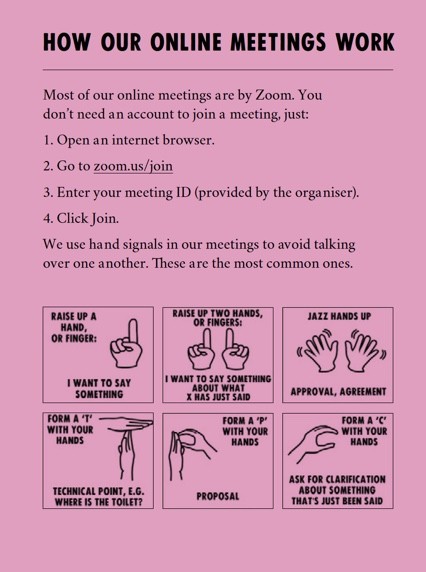How our online meetings work
Many of our online meetings use Zoom. You don't need an account to join a meeting, just:
- Open an internet browser.
- Go to zoom.us/join
- Enter your meeting ID (provided by the organiser)
- Click Join
This video shows how to set up Zoom if you haven't used it before:
Most of our meetings have:
Check-ins: where we introduce ourselves and share how we are doing.
A Regenerative Culture Reminder: we remind ourselves to be kind to one another as parts of XR, and that we don't blame or shame. We pay attention to our feelings and no-one takes on too many tasks. If we feel overwhelmed we can ask for help.
A facilitator: one person is designated to make sure everyone is heard and that we stay on task.
A minute taker: one person writes down the key things mentioned in the meeting.
Check-outs: we briefly say how we feel the meeting went or what we are each looking forward to today.
We use hand signals in our meetings to avoid talking over one another. These are the most common ones:
Hand Signals

When someone in the group wants to say something, they should point their index finger up and wait for the facilitator to let them have their turn in speaking. It is vital that people do not talk over anyone else and wait for their turn. If someone, who has not yet said anything, puts their finger up to speak, whilst others have spoken a lot, then the facilitator should give that person priority over the 'stack' (the queue or order of speakers based on the order they raised their finger to speak).
Direct Point:
If someone has directly relevant information to what is being said, then they can make the 'direct point' hand signal and the facilitator will let them provide that information immediately after the person speaking has finished. Think of the direct point hand signal as being like brackets, which are used to add critical information that a speaker is not aware of e.g. “the meeting has now been changed to Wednesday”. The direct point signal is not an excuse to jump the queue just to make a point. It is important that people do not abuse this signal as otherwise it can make all present lose trust in the process.
Wavy Hands (I Agree):
The 'wavy hands' signal of approval is used to show agreement or support for something someone has said. It instantly indicates how much consensus there is towards something and can highlight how popular an idea is. If everybody erupts into a forest of waving hands during a breakout session, for example, the note taker can see that this is one of the more popular points made and it will become one of the key bullet points fed back to the main meeting room.
Clarification:
If someone says something that is unclear, people can hold their hand in a ‘C’ shape as the 'clarification' signal. The facilitator will then pause the discussion giving the person who made the signal the opportunity to ask a question to clear up any confusion. This signal should be given priority above all others as it means that someone does not understand something and it may thus inhibit their ability to engage in the discussion.
Technical point:
If someone has information that is immediately relevant to the running of the meeting, they make a 'technical point' signal by making a ‘T’ shape with their hands. This is only to be used for concerns external to the discussion that need to be addressed immediately e.g. “We only have ten minutes of this meeting left” or “I am the note taker and I need the loo so can someone else take over?” The facilitator should stop the discussion to address the technical point.
Round Up:
Facilitators need to ensure that no one speaks for more than necessary (two minutes is a suggested maximum amount of time as it encourages people to be concise). If someone has been speaking for two minutes (or whatever the set amount of time is), the facilitator makes the ‘round up’ hand signal by repeatedly making a circular motion with their hands (as if they are tracing a ball). This must be done sensitively, but firmly as it ensures that no one person dominates the meeting.
Speak up:
If someone is speaking too quietly or they cannot be heard, others can ask them to raise their voice by raising and lowering their hands with palms open and facing up.
>> NEXT PAGE: Climate grief and anxiety
>> Back to Rebel Start Pack CONTENTS
